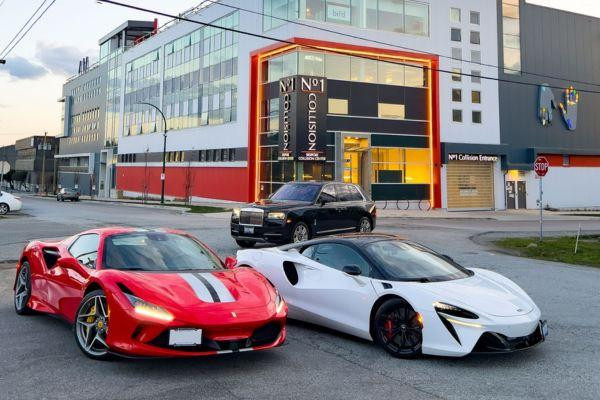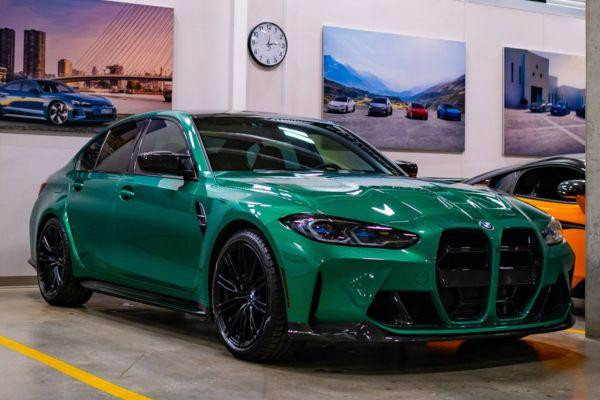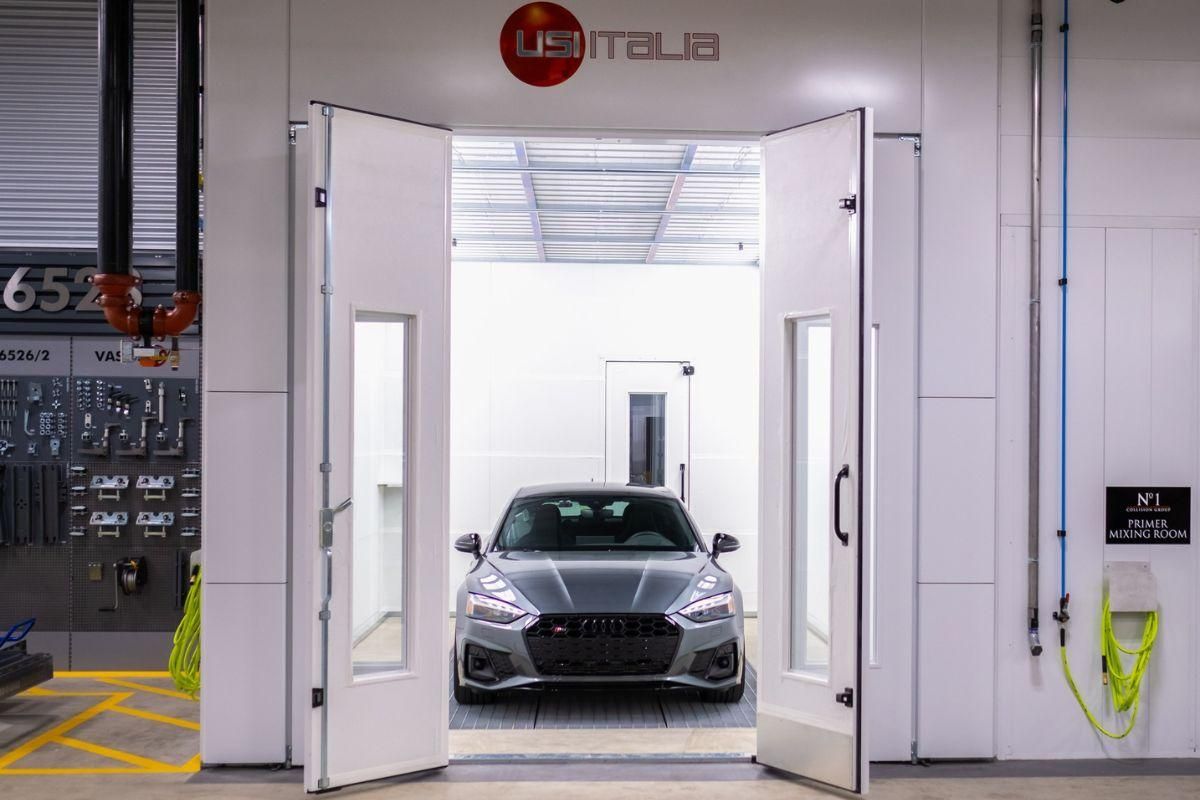Bruce Sorensen Jr. is a master paint technician with years of experience working on luxury vehicles at No. 1 Collision Group, an MSO with five locations in Canada, one in Bellingham, WA, and another coming soon in Newport Beach, CA.
He recently appeared on The Collision Vision podcast, driven by Autobody News and hosted by Cole Strandberg, to discuss OEM certified refinishing and the precision and tools required to work on high-end vehicles.
Getting Started in Collision Repair Refinishing
Sorensen said he grew up a creative kid. When he was 15, he worked on his first car. He later received on-the-job training in a collision repair shop.
“We were combo techs at the time,” Sorensen said of his first job in a shop. “You cleaned the bathrooms, you swept the floor, you replaced quarter panels, you painted the car, you sand the car, you did the whole thing.”
Sorensen said his employer told him he would be a painter someday, but Sorensen “shrugged it off…I had no idea at that time, probably 18, 19 years old, that later it would come full circle, and what I'm into now, which is amazing. So it was quite the journey.”
 He has applied the skills he’s learned over the last nearly three decades to his current position working on premium vehicles with No. 1 Collision Group. Strandberg asked about the unique challenges related to working on those types of vehicles.
He has applied the skills he’s learned over the last nearly three decades to his current position working on premium vehicles with No. 1 Collision Group. Strandberg asked about the unique challenges related to working on those types of vehicles.
“That's always a tough one, because we really try to keep standard and premium the same,” Sorensen said.
The technicians at No. 1 have invested a lot of time and money into training to ensure the same quality of work, no matter the vehicle make, Sorensen said.
“The quality has to be presented the same, and the pride has to be presented the same,” he added.
OEM certifications can play a big role in how the technicians repair some cars.
“Our techs are more and more trained, almost to a doctor level, of working on vehicles. There's no more panel beaters anymore,” Sorensen said. “They're very precise.”
No. 1 schedules and pays for its techs’ OEM certification training. For someone who has to do that on their own, it may seem daunting, but it’s worth it, Sorensen said.
“You can't have enough [certifications] in how this is pushing the craft in the future,” he said. “The certifications are going to be the future of the trade.”
Sorensen acknowledged the training is less travel-intensive for paint techs like himself, as it is mostly online, while body techs usually have to go an automaker’s facility. Sometimes those trips can be to interesting locations though -- recently some body techs at No. 1 went to Germany for Porsche training.
Tools and Technology
Strandberg asked what tools and techniques Sorensen relies on most to achieve perfection when refinishing high-end vehicles.
“The biggest thing that I rely on is paint guns,” Sorensen said, adding he looks for consistency and reliability that allows him to match any texture, as well as great customer service from the manufacturer.
He also needs a good camera system and paint booth.
“Paint booths don't get looked at enough, being a huge part of your refinish,” he said. He prefers one that provides good airflow and dust control.
Color Matching in High-End Refinishing
Strandberg asked how Sorensen color matches finishes on cars made by BMW and Mercedes-Benz that until recently may have only been available on exotics.
 A customer's refinished BMW.
A customer's refinished BMW.
Sorensen said he gets information from the OEM, as well as field formulas from techs across the U.S.
“They have great documentation, even in the chips. The chips are all sprayed. They're not printed. So the reliability on the chips is is bar none,” he said. “And that still comes with spray outs. You still have to do spray outs in your own environment, the temperatures in your booth, the humidity, different paint guns, different air pressures. They're all going to change the color slightly. Doing spray outs is 100% key to a successful color match.”
Some of the finishes may seem difficult, but refinish techs should jump in and try them. “You never know until you get the first one done,” Sorensen said. “Practicing your trade is key.”
Refinishing high-end vehicles can also require problem-solving.
“There's been many times that I'll look up a formula and it's got a brand new toner in it. I don't have that toner. This car still needs to be sprayed today. I won't be able to get that toner. What do I do?” Sorensen said. “You come up with crazy solutions sometimes.
“Sometimes you're flipping through chips and looking for something to start with. You find something to start with. You start supplementing different toners to get you to that level. That's where maybe the art, the chemistry part of it comes from,” he said.
“The figure-it-out part is one of the biggest parts in the trade,” Sorensen added.
Strandberg asked if Sorensen has any favorite finishes -- or any he dreads.
“I love blue, but I don't really love a blue car,” Sorensen said. “I love spraying black. It's very easy. It's a great money maker. Everybody's in it for the money, no matter what.
“I just did another flat, clear job this past week,” Sorensen said. Those can be intimidating, but again, Sorensen said to “just calm down. Take it easy, work through it. It's no big deal. And that's no different than any other, harder color or different texture,“ he said, like some of the greens Mercedes-Benz, BMW and Porsche have come up with.
How to Become a Great Refinish Tech
Sorensen said becoming a great refinish tech starts with having a process in place.
“I have a process. I stick to my process. Some may think that my process is a little overkill; it works for me,” he said. “It hasn't worked for a lot of people that have worked under me, but my team right now is amazing. They stick to the process and we try to achieve great finishes, some of the best finishes around.”
Strandberg asked about balancing efficiency with quality when working on more complex finishes.
“It can be tough because we all have to bring home a paycheck,” Sorensen acknowledged. “I will put that aside to really care about what you're doing. The money will come later. You can't always worry about how fast you could get something through.”
Sorensen said it’s important to focus on making sure the car is repaired and refinished in such a way that you can be proud of it and the customer will appreciate it.
“You really have to be obsessed,” he said. “In this field, the passion, the commitment all plays a role of doing high end finishes.”
Aspiring refinish techs should “practice your trade,” Sorensen said. “Being passionate is the only way you can get to the top.
“I don't feel like I'm at the top yet. I feel like I have a ways to go,” he said. “There's a lot of people out there, a lot of refinish techs that I would say they're way further along than me.
“Being obsessed is probably one of the funniest keys that my wife gives me crap about,” he added. “But being obsessed…is probably the only way you're going to get there.”














Abby Andrews